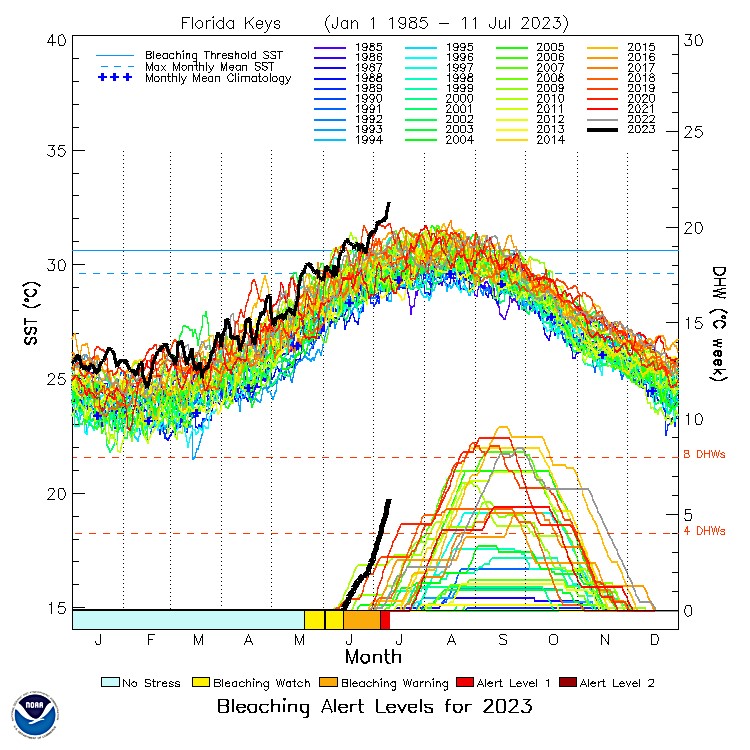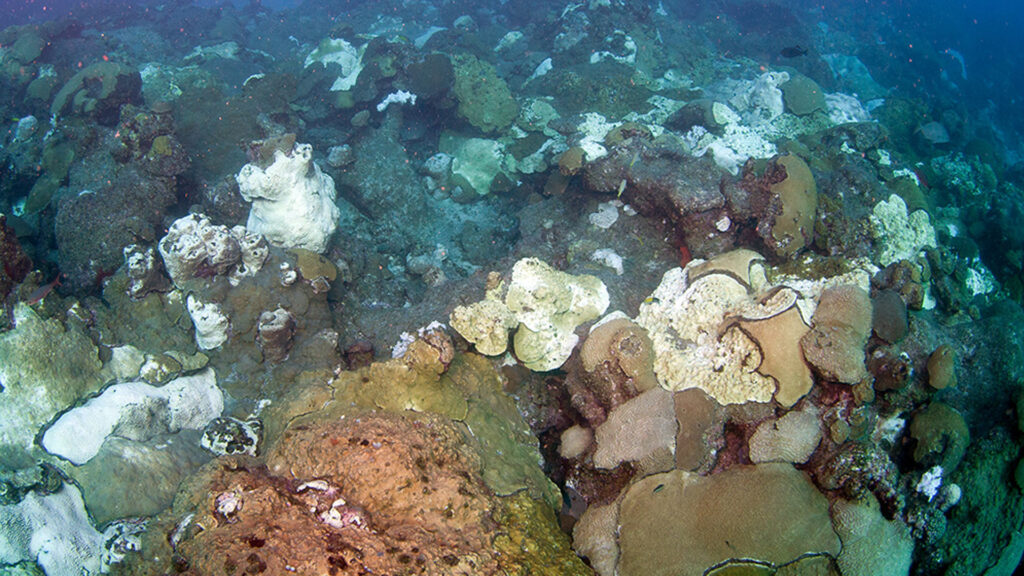By NOAA’s National Environmental Satellite, Data, and Information Service

National Oceanic and Atmospheric Administration satellites are tracking the steady climb in ocean temperatures since April, which is causing unprecedented heat stress conditions in the Caribbean Basin, including waters surrounding Florida and in the Gulf of Mexico. The current marine heat wave is raising new concerns about the potential impact on the fragile coral reefs beneath the ocean’s surface.
Derek Manzello, Ph.D., coordinator of NOAA’s Coral Reef Watch, has researched the impacts of ocean warming around the Florida Keys for more than 20 years. During that time, he has examined five different warm-water coral bleaching events, both on location and with remote-sensing technology. He sat down this week and put the developing heat event into context.
What type of impacts do hot ocean temperatures have on coral reefs?
Manzello: If ocean temperatures are higher than the maximum monthly average, for a month or more, especially during the warmest part of the year — even by as little as 1-2 degrees Celsius (2-3 degrees Fahrenheit) — corals will experience bleaching.
A bleached coral is essentially starving to death because it has lost its main source of nutrition — the algae that live symbiotically within its tissues. The damage corals experience from marine heatwaves is a function of the duration, or how long the heat stress occurs, plus the magnitude of the heat stress. Corals can recover from bleaching if the heat stress subsides, but the corals that are able to recover frequently have impaired growth and reproduction, and are susceptible to disease for two to four years after recovery. There are downstream, negative impacts to the corals that are able to survive a heat stress event.
If the heat stress does not subside, the coral will die. Mortality becomes likely if the corals experience sea temperatures 1°C greater than the historical maximum monthly average for two months, or 2°C greater than the maximum monthly average for one month. Also, if there is a temperature deviation of say 3°C, then the corals would be expected to start experiencing mortality in less than three weeks.
How unprecedented and concerning is this current marine heatwave in Florida?
Manzello: The data we are seeing show sea surface temperatures (SSTs) are hotter than they have ever been in the satellite record (dating back to 1985) this early in the year. In the figure, the black line represents 2023, and you can see that SSTs have been among the hottest on record all year. When the SSTs surpass the solid blue, horizontal line, the corals will start becoming heat stressed.

During previous, large-scale bleaching events in the Florida Keys (the most recent severe events were in 2014 and 2015), the bleaching-level SSTs did not occur until mid-August. So, we are a full month ahead of what we, historically, have called the normal “bleaching season.” What this means is, unless significant cooling takes place (for example, repeat passage of hurricanes, or tropical storms), the corals of the Florida Keys may be looking at upwards of three consecutive months of thermally-stressful conditions. This would be unprecedented in the satellite record because most previous bleaching events lasted about four to six weeks.
What are the implications for the coral reefs around Florida?

Manzello: It is extremely concerning for the coral reef ecosystems in Florida that temperatures are so hot, so early in the year. There have been eight, documented mass bleaching events that have impacted the Florida Keys since 1987. Coral bleaching events, due to ocean warming, are becoming more frequent and more severe in Florida, as well as globally.
The coral reefs of the Florida Keys have undergone a dramatic decline since the late 1970s, primarily due to disease and coral bleaching, both of which are directly linked to increasing ocean temperatures. Many coral reefs in the Florida Keys have lost much of their coral cover. Recent research by both NOAA and the U.S. Geological Survey has shown that 70% of Florida’s coral reef tract is in a net erosional state, which means the reef framework structures are slowly eroding.
This is alarming because the many marine species that inhabit coral reefs are directly dependent on the three dimensional, architecturally complex framework structure of coral reefs. We are losing this structure because there is not enough live coral left to maintain and build it. Many species that rely on coral reef habitat are vital to Florida’s economy, such as various fishes, spiny lobster and stone crabs. We are already losing vital habitat in the Florida Keys that so many organisms depend on for their survival.
Are there efforts underway to mitigate the problem?
Manzello: Yes – the Mission Iconic Reefs program is urgently working to grow corals and outplant them to seven different “iconic” reefs of the Florida Keys. The goal is to restore coral cover and ensure the ecological services provided by these reefs are maintained. Coral reefs provide shoreline protection from storms and sea-level rise; thus, keeping them healthy and maintaining their structure are extremely important for the people that reside in coastal areas near coral reefs.
It’s a race against time for managers and scientists to outrun a rapidly warming ocean, to try and restore Florida’s cherished coral reefs.
Unfortunately, the heat stress is likely just beginning this year and is far from over. Unless there are atmospheric or oceanographic changes/events that cause cooling, the amount of heat we are seeing for the Caribbean region and Florida this early in the year is very concerning.
![NOAA Coral Reef Watch’s Four-Month Coral Bleaching Outlook of July 11, 2023, for the period July-October 2023. Bleaching-level heat stress is predicted to strengthen further and continue, during the next four months, in the Eastern Tropical Pacific (where coral bleaching has already been confirmed off the coasts of Mexico, El Salvador, Costa Rica, and Columbia); in the Caribbean (where bleaching has been confirmed already in Belize and off both sides of the Yucatan peninsula [Mexico]); and in multiple other coral reef regions.](https://www.theinvadingsea.com/wp-content/uploads/2023/07/2023-07_cur_cfsv2_outlook-4mon_v5_60pct_45ns.jpeg)
This piece was originally published at https://www.nesdis.noaa.gov/news/rising-ocean-temps-raise-new-concerns-coral-reefs
Sign up for The Invading Sea newsletter by visiting here.



